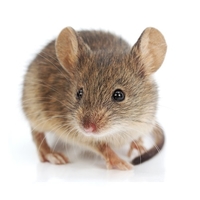How to Identify the House Mouse
The house mouse is a small, gray, 4-legged, short-haired animal. As an adult, it is 2.5 to almost 4 inches long; from the nose to the tip of its tail, it is approximately 7 inches long and weighs about 1 ounce. Since the house mouse is nocturnal and active at night, you actually may not see the mouse. The first indications will be mouse droppings on the counter, in lower kitchen cabinets, storage rooms, garages, etc. The mouse droppings are 1/4 to 3/8 inches long, rod-shaped with pointed ends and black in color. An adult house mouse can produce up to 50 droppings a day.
Mice are among the most important pests in Raleigh, Charlotte, and Wilmington, residentially and commercially. Obviously, just the presence of a mouse is a nuisance, but they can also carry many common diseases; the most threatening organism they carry is Salmonella, which can result in food poisoning.
Where do House Mice Come From?
- The house mouse or mice populations start from outside and move inside due to overpopulation or reduction of food.
- During the night, while foraging, they crawl into weep holes, under garage doors, loose crawlspace and storage doors, broken foundation vents, into cracks where utility lines enter a building, or up the outsides of the home and into the structure where the environment is suitable, with plenty of food and available nesting sites.
- If all conditions are met, they will not have to leave the building. They are shy and also inquisitive little creatures and may investigate new surrounding for about a week before they start to move into your home.
- They will then explore and re-explore their new surrounding until they know every nook and cranny in your building. Once inside the home, they will move throughout the entire house using wall voids as passageways.
- Often, homeowners will hear the rustling noises in the walls to indicate their presence.
The Biology and Behavior of House Mice

The house mouse is an impressive and prolific breeder. The house mouse reaches sexual maturity at about 5-8 weeks. Their pregnancy lasts about 19 days. The litter is between 4 and 7 pups. They are born naked and blind. Within 10 days, they are covered with fur and the eyes and ears are open. After the 5th week, the pups are weaned and are sexually mature. A female can have 8 litters per year with an average of 6 pups which equals to 48 young per year.
The house mouse inside a building will set up its nest close to food sources. Once the nest is established and there is a readily-available food source, the mouse will stay close to the nest and only take short trips to explore and re-explore its territory. The house mouse needs extremely small amounts of water and can extract the moisture it needs from its food source.
Ways to reduce the conditions that harbor and attract the mice:
- Remove leaf clutter near structure
- Remove brush piles from structure
- Seal gaps around doors and windows
- Rodent-proof your HVAC system
- Repair and/or caulk foundation cracks
- Install door sweeps and, if necessary, new doors
- Repair moisture-damaged wood inside and outside structure
- Repair foundation vent screens
- Clean gutters and downspouts of debris
- Clean garbage cans
- Move garbage cans 25 feet from structure
- Clean all pet food dishes and remove spilled pet food
- Remove all loose birdseed and place in protected containers
- Repair all leaks in structure
- Seek professional assistance and a pest prevention plan
Economy Exterminators’ Pest Control Solutions program uses the 4-step approach to solve your mouse problem:
- Our 1st step is the inspection of the property by a Charlotte, Wilmington or Raleigh customer service specialist. It is very important to know the rodent species involved and the severity of the pest problem.
- The 2nd step is the initial treatment by a customer service specialist of all areas that the inspection revealed as critical areas. Economy Exterminators uses the newest and most effective baits, traps and materials to solve this pest problem fast for you. Critical areas usually include the kitchen, storage areas, crawlspaces, garages and the exterior of the building.
- The 3rd step is a 37-point inspection of your property to identify areas around the outside of your house that give easy access to the mouse.
- The 4th step is an ongoing maintenance program, such as our pest control programs, to prevent the next generation of house mouse from infesting your home.





